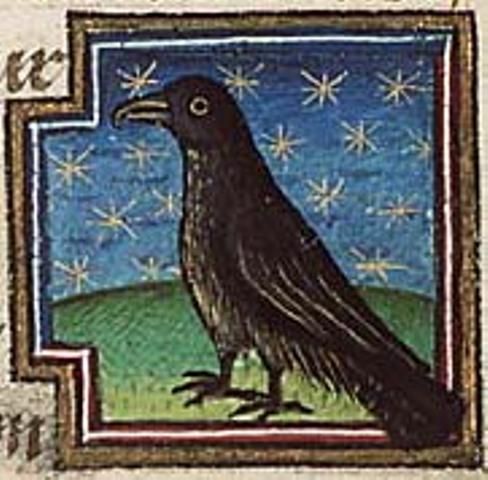















Baile the Sweet-Spoken, Son of Búan
The three grandsons of Capa, son of Cinga, son of Ros, son of Rudraige, were Monach, and Búan[1] and Fer-Corb, a quibus[2] Dál mBúain and Dál Cuirb, and the Monachs of Arad.[3]
Búan’s only son was Baile; he was the specially beloved of Aillinn, the daughter of Lugaid son of Fergus Fairge[4] (or the daughter of Eogan, the son of Dathi).[5] And he was the specially beloved of every one who saw or heard him, both men and women, on account of his novel stories. And they made an appointment to meet at Ros na Ríg,[6] at Lann Máelduib, on the brink of the Boyne in Brega.
The man[7] came from the north to meet her, from Emain Macha, over Sílab Fúaid,[8] over Muirtheimne[9] to Tráig Baile.[10] Here they unyoked their chariots, sent their horses out to graze, and turned themselves to pleasure and happiness.
While there, they saw a horrible spectral personage coming towards them from the south. Vehement was his step and his rapid progress. The manner in which he sped over the earth might be compared to the darting of a hawk down a cliff; or to wind from off the green sea. His left was towards the land.
‘Let him be met,’ said Baile, ‘to ask him where he goes, and where he comes from, and what is the cause of his haste.’ ‘To Túag Inbir[11] I go back, to the north, now, from Sílab Suide Laigen,[12] and I have no news but of the daughter of Lugaid son of Fergus, who had fallen in love with Baile son of Búan, and was coming to meet him, until the youths of Leinster overtook her, and she was killed by the forcible detention, as it was promised by druids and good prophets for them, and that they would not part for ever after. This is my news.’ And he darted away from them like a blast of wind over the green sea, and they were not able to detain him.
When Baile heard this, he fell dead without life, and his tomb was raised, and his ráth,[13] and his tombstone was set up, and his fair of lamentation was held by the Ultonians. And a yew tree grew up through his grave, and the form and shape of Baile’s head was visible on top of it, hence Tráig Baile.
Afterwards the same man went to the south to where the maiden Aillinn was, and went into the gríanán.[14] ‘Whence comes the man that we do not know?’ said the maiden. ‘From the northern half of Erinn, from Túag Inbir, and past this place to Slíab Suide Laigen.’ ‘Have you news?’ said the maiden. ‘I have no news worth relating now, but that I have seen the Ultonians holding a fair of lamentation, and raising a ráth, and erecting a stone, and writing his name, to Baile son of Búan, the rígdamn[15] of Ulster, by the side of Tráig Baile, [who died] whilst he was coming to meet a favourite and beloved woman to whom he had given love; for it is not destined for them that they should reach each other alive, or that one of them should see the other alive.’ He darted off after telling the evil news. Aillinn fell dead without life, and her tomb was raised, etc. And an apple—tree grew through her grave, and became a great tree at the end of seven years, and the shape of Aillinn’s head upon its top.
At the end of seven years, poets and prophets and visioners cut down the yew which was over the grave of Baile, and they made a poet’s tablet of it, and they wrote the visions and the espousals and the loves and the courtships of Ulster in it. [The apple-tree which grew over Aillinn was also cut down and] in the same way the courtships of Leinster were written in it.
When Samain had arrived, afterwards, and its festival was made by Art the son of Conn, the poets and the professors of every art came to that feast, as it was their custom, and they brought their tablets with them. And these tablets also came there, and Art saw them, and when he saw them he asked for them. And the two tablets were brought, and he held them in his hands face to face. Suddenly the one tablet of them sprang upon the other, and they became united the same as woodbine around a twig, and it was not possible to separate them. And they were preserved like every other jewel in the treasury at Tara, until it was burned by Dúnlang the son of Énna,[16] namely, at the time that he burned the princesses at Tara.
NOTES:
1. MS ‘Baile’ is corrected to ‘Buan’.
2. i.e. ‘from whom are’.
3. All these territories are in County Down.
4. Descended from Núadu Necht, legendary ancestor of most Irish dynasties.
5. An alternative descent; the identity of Eogan and Dashi is uncertain.
6. Rosnaree, a ford on the Boyne, near Slane, County Meath.
7. i.e. Baile.
8. Pews mountains, County Armagh.
9. Muirtheimne Plain, extending from Drogheda to Dundalk, County Louth.
10. In English, ‘Baile’s Strand’, at Dundalk.
11. Estuary of the Benn, County Derry.
12. Mount Leinsscr, in the barony of Ferns, County Wexford.
13. English ‘rash, enclosure’.
14. English ‘sunny chamber’.
15. English ‘royal heir’.
16. An early Leinster king, reputed to have burned thirty princesses with their retinues, on account of which the Bóruma tribute was re-imposed.
SOURCE: O’Curry, Eugene. Lectures on the Manuscript Materials of Ancient Irish History (Dublin, 1861; rpr. Dublin: Four Courts Press, 1995), pp. 472—5.